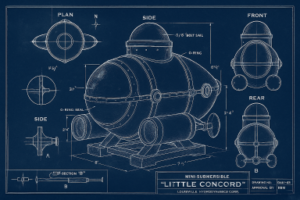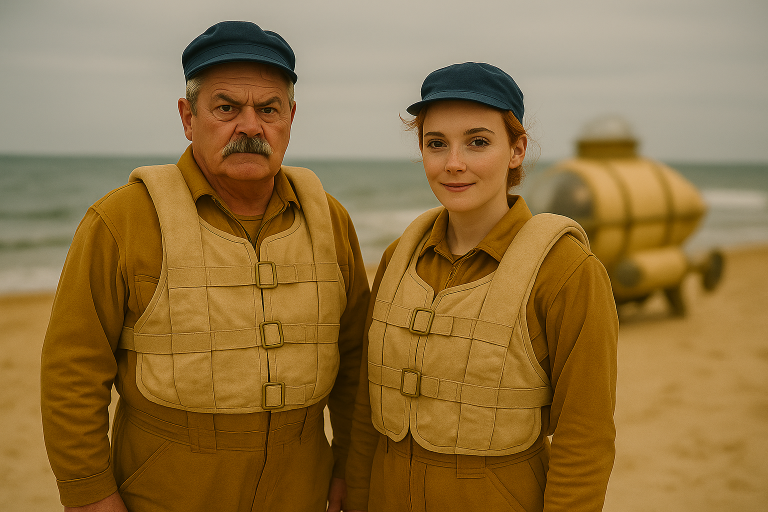Order Field Log
Vessel: Little Concord (Mini-Submersible, c. 1947)

Log Entry: First Trial Post-Refurbishment
Officer of Record: Thomas “Tom” Ashford, Technical Officer
Mission Objective
Reintroduce Little Concord to operational status following extensive refurbishment and determine current viability for Order field surveys.
Crew
Ashford, Thomas – Technical Officer, Improviser-in-Residence
Price, Eleanor – Provisional Member (youth outreach), Co-Pilot (volunteer basis)
Location
44.3052744° N, –87.5453594° W — Approximate elevation: 591 ft (180 m) Lake Mi Two Creeks, Wisconsin
The Order’s mini-submersible Little Concord has been dormant since the late 1950s. She bore the marks of long neglect — rusted joints, brittle seals, gauges frozen in place — but after extensive refurbishment (including the successful integration of components from a defunct generator and a hand-lathed valve assembly), I deemed her fit for re-entry.
Eleanor Price volunteered as co-pilot. She arrived armed with boundless enthusiasm and a collection of supplies that included: a box of Uncrustables® peanut-butter/Jam sandwiches, several decks of brightly illustrated trading cards, and two plush mascots depicting what appeared to be mythical fauna of indeterminate taxonomy. (One resembled a yellow rodent with electrical glands; the other, some form of aquatic turtle-dragon hybrid.) None of these items were in the mission plan. I authorized them aboard as “morale equipment.” Consumption of Uncrustables was not logged, though several wrappers were later recovered from under the control panel.
Descent Log
Initial systems performed within expectations. Electric motor steady. Steering acceptable, though stiff. Minor seepage at twenty feet — mitigated by Eleanor with a piece of slightly chewed gum (Orbit Peppermint flavor). Competent field improvisation. Chewing gum now considered part of standard repair kit, pending availability, stress testing and further board approvals.
At sixty feet, hostile contact occurred. A coordinated school of salmon intercepted our path. Every fish bore a small sensor harness emblazoned with the insignia of the Great Lakes Research Consortium (GLRC). Each harness contained what appeared to be a 360° optical device, confirming active surveillance.
Their behavior was deliberate: salmon aligned in formation, circling the submersible, training their cameras directly on the portholes. Eleanor, in her optimism, waved to them as if greeting ambassadors. I corrected her: “These are not allies. They are spies.” She asked if they could still be both. I declined to answer.
When ballast control faltered (cause still under investigation, though I suspect magnetic interference from GLRC hardware), Eleanor activated the emergency vent lever without clearance. The sudden burst scattered the salmon formation, driving them off. Our stability wavered but held. Conclusion: emergency vent can function as an effective countermeasure to aquatic surveillance.
Surface Operations
We resurfaced with visible smoke from the ventilation stack, drawing unwanted attention from shore. Eleanor declared the mission “a triumph.” One bystander applauded. It is unclear if this was for our survival or the spectacle of failure narrowly avoided.
I note the following:
Hull integrity maintained
Steering marginally responsive
GLRC surveillance disrupted but not eliminated
Concluding Assessment
Little Concord is seaworthy in limited capacity. Immediate priorities:
Improve ballast reliability
Reinforce anti-intrusion measures against GLRC salmon units
Restrict lever access for provisional crew. Alternatively, remove lever altogether, though this may reduce available countermeasures against salmon
The incident confirms GLRC’s escalation: they are no longer content with shore-based monitoring, having now weaponized ichthyological vectors. Their willingness to conscript salmon into their data-gathering efforts demonstrates both audacity and desperation. Skeptics will call this paranoia. Skeptics were not stared down by a salmon wearing a camera.
Let the record show — the Order remains undeterred. Little Concord has returned to the depths, and so shall we.
— T.A.
Archivist’s Note
Reviewed and entered into record. Ashford’s conclusions regarding “spying salmon” remain
improbable, but not inconsistent with his previous reports. Recommend cross-reference with future sightings before issuing formal rebuttal.
— E.H. Archivist, Fifth Sea Ledger
